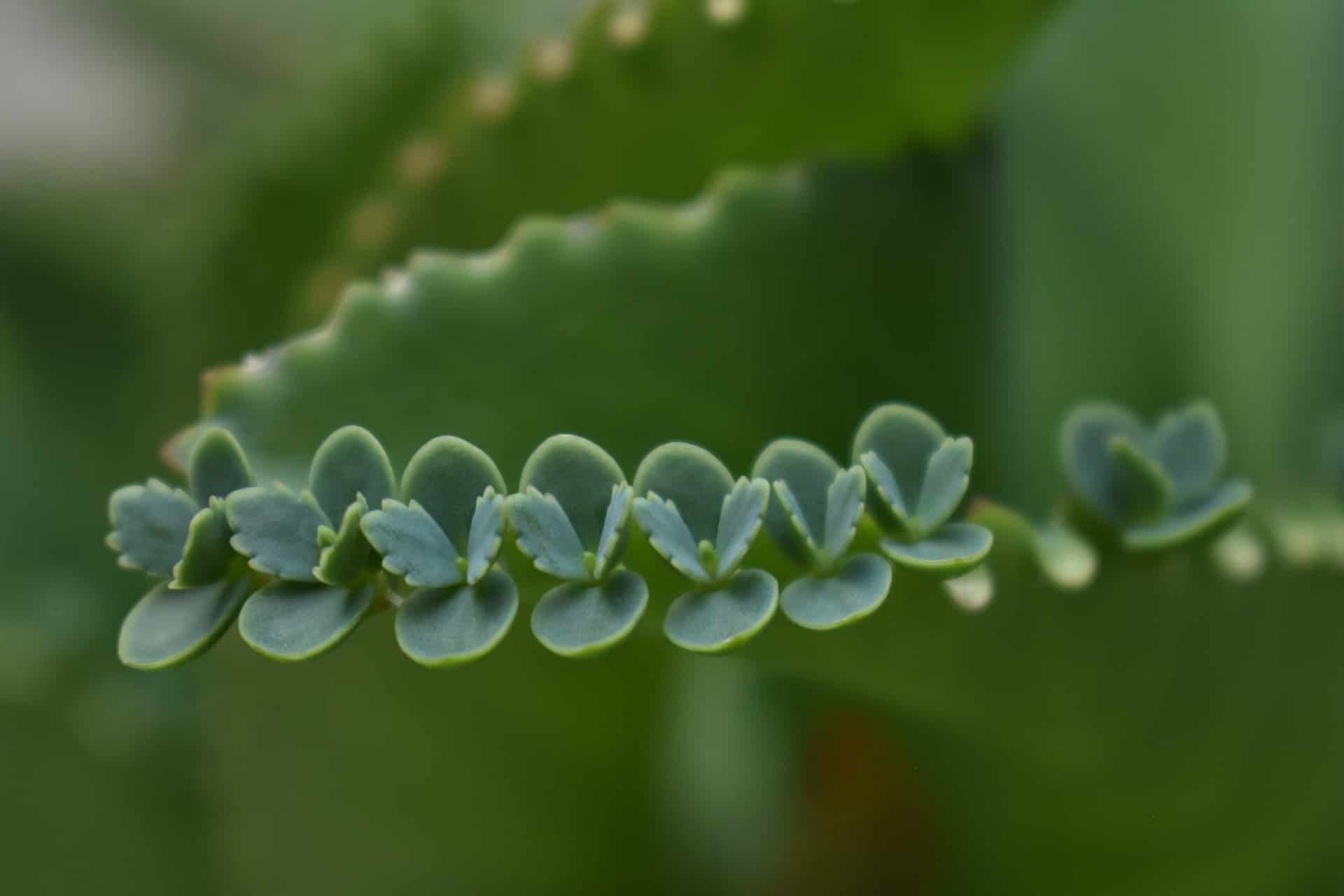Easy going – check. Distinctive – check. Unique and attractive? Also checking those boxes off by Bryophyllum daigremontianum, Kalanchoe daigremontiana,or the Mother of Thousands plant. The forgiving, low maintenance, drought-resistant succulent is beautiful, easy to care for and thrives outdoors in warm climates and indoors in cooler locales.
Classification of Mother of Thousands
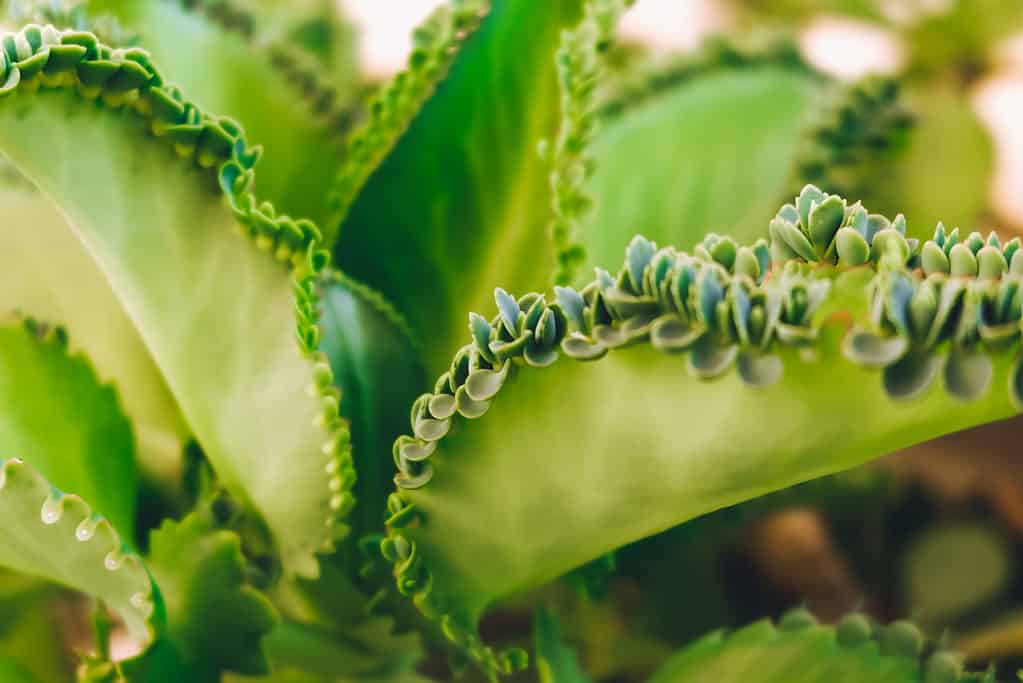
Mother of Thousands, Mexican Hat plant, devil’s backbone, or alligator plant
©iStock.com/PUGUN SJ
The Mother of Thousands plant may be found as either Bryophyllum daigremontianum or Kalanchoe daigremontiana, depending on who’s writing about the plant or selling it. Additionally, it has many nicknames, including Alligator plant, Mexican hat plant, and Devil’s backbone.
The plant belongs to the Crassulaceae family and is a succulent that grows native in Madagascar. The genus formerly known as Bryophyllum now known as Kalanchoe (thus the varying names for this plant) contains this species along with many others that are often confused with the Mother of Thousands plant, including the chandelier plant and Palm tree Bryophyllum.
The Mother of Thousands plant is related to the jade plant and the Flaming Katy.
Mother of Thousands do not reproduce via seeds but rather plantlets, which develop rapidly and frequently, which is where the plant gets its common name.
The plant is drought resistant.
Description of Mother of Thousands Plant
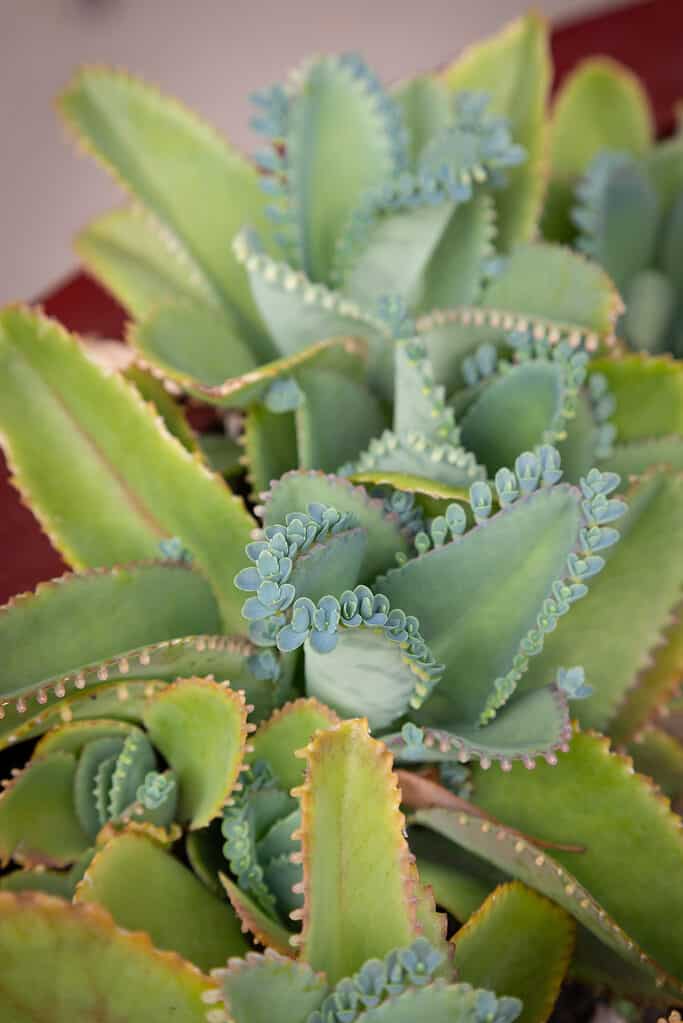
The plant may be yellow-green when older or unhealthy or dusty gray-blue-green when healthy and vibrant.
©iStock.com/Athichai Chaweesook
The mother of thousands plant is a unique looking succulent that generally has bright yellow-green or a dusty blue-gray-green leaves. The maturity and health of the plant will determine the shade, as well as the amount of light the plant receives.
Most plants in this genus are prized for their flowers, but the mother of thousands rarely blooms – and almost never does so indoors. Instead, the large blue-green leaves ripple with little baby mother of thousands on the edges of the leaves. These are known as plantlets. When the plant does happen to bloom on those rare occasions, the flowers are a grayish-pink or grayish-red bloom, tubular shaped, and droopy.
The leaves have pointed tips and grow in pairs from the stem. As the plants mature, each pair of leaves staggers opposite each other, with new leaf pairs growing in at 90 degrees away from the older ones. The leaves may be between 3 and 6 inches wide.
Types and Cultivars of Mother of Thousands
Mother of Thousands are one of the species in the Kalanchoe genus. They do not have any cultivars. You are likely to find many articles listing “varieties of Mother of Thousands” but these other plants are actually referring to similar plants like the chandelier plant or mother of millions, but they are not types of mother of thousands plants.
Where and How to Find Mother of Thousands Plants
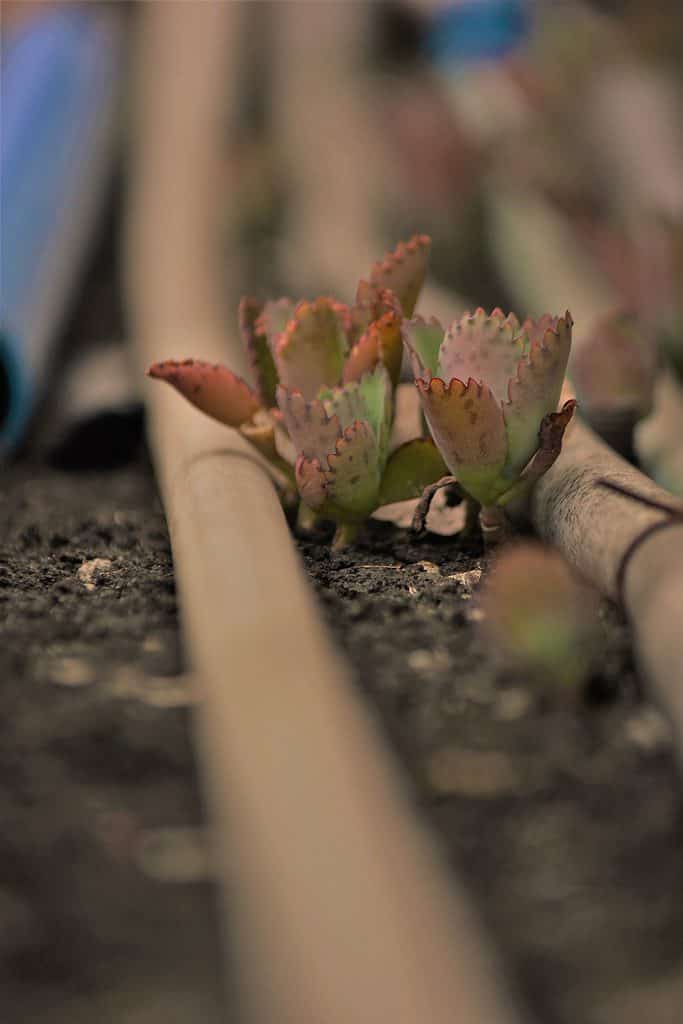
They may pop up anywhere that a mother plant has dropped them.
©
Natively, the mother of thousands plant grows in Madagascar off the eastern coast of the mainland African continent. The plants are native to the Fiherernana River Valley and Androhibolava mountains in the southwestern region of the country. The plant has been introduced to multiple other locations around the world, including Puerto Rico, Venezuela, Brazil, Hawaii, Florida, Argentina, and even parts of southern Europe near the Mediterranean.
The plants grow naturally in arid environs, so drier, temperate climates are where they do best when growing outdoors.
To purchase a mother of thousands plant, you will want to look for labels for Bryophyllum daigremontianum or Kalanchoe daigremontiana. You’ll find these at the occasional nursery, garden center, succulent nursery, or online. For online shops, be sure to read reviews thoroughly to ensure the source is reputable and reliable.
Uses for Mother of Thousands
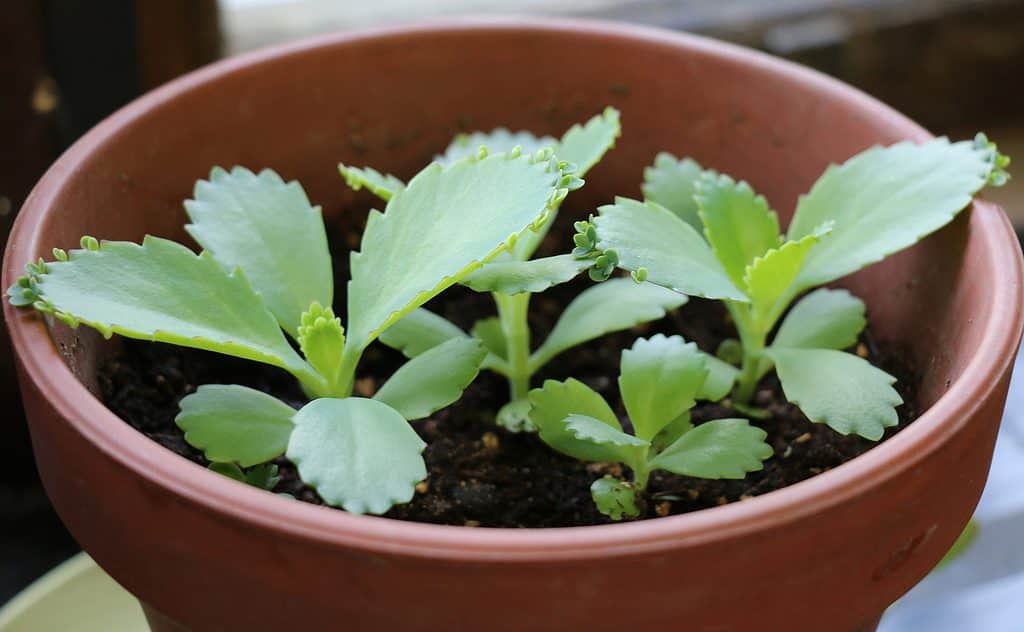
The plant has been used in traditional medicine for centuries. Scientists are now studying its effects for major conditions and diseases.
The mother of thousands plant is actually fairly toxic and can cause various issues when handled improperly or ingested. It’s important to keep the plant out of reach of children and pets, and should be handled only while wearing gloves.
Interestingly, though, the plant has a long history of use as a traditional medical plant. It has been used as remedies for many situations, including prevention of premature labor, treating infertility, treating rheumatism, burns, inflammation, high blood pressure, renal colic, diarrhea, infections, and abscesses.
One chemical compound found in the plant is the bufadienolide, which has, in some circumstances, shown to help prevent or treat tumors in-vitro and in-vivo trials. Most of the studies have only been conducted in mice, however, and the steroid is dangerous outside of strict medical use by professionals only.
Never attempt to use mother of thousands to treat any conditions on your own, as you could cause severe health issues.
How to Care for Mother of Thousands Plants
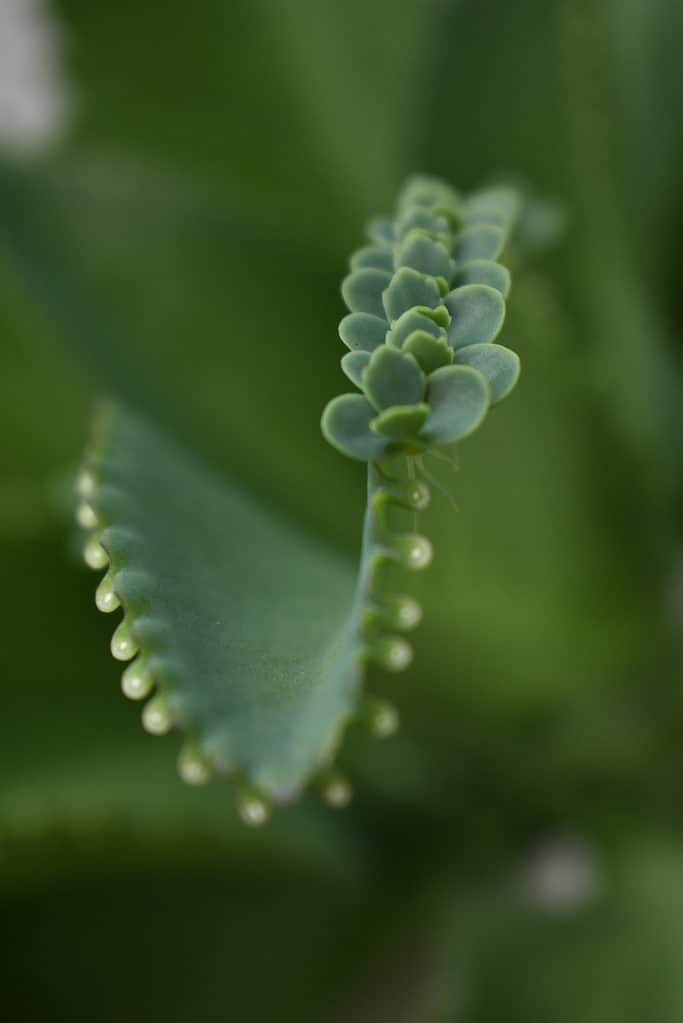
The tiny plantlets drop from the mother plant and spread quickly.
©
We have created a full care guide for this plant, which can give you all the details for light, water, soil, planter, and other needs.
The basics, however, include:
- Provide bright, indirect light (that isn’t too hot) to the mother of thousands plant for approximately 6 hours per day.
- Keep the plant in temperatures between 65- and 75-degrees F.
- Place the plant away from air vents, heaters, air conditioners, dryers, and doors that open outside.
- Plant them in well-draining, sandy soil.
- Ensure their planters have proper drainage holes.
- Water the plant with room temperature water every 2 to 4 weeks, depending on the season.
If you’re interested in keeping the plant easily out of reach, we have a hanging plant ideas guide. You’ll also find a detailed watering guide and the meaning of mother of thousands article to add more value to your care.
Mother of Thousands and Animals
As mentioned previously, mother of thousands plants are toxic and therefore dangerous to both humans and animals. Ideally, keep them as hanging plants, whether indoors or out, and keep them away from children and pets.
Thank you for reading! Have some feedback for us? Contact the AZ Animals editorial team.

